Parish's Goldeneye
Bahiopsis parishii
(Viguiera deltoidea)

The cone-like structures at left are galls produced by the plant in response to the feeding of tiny moth larvae. At right an achene with its subtending bract is shown enlarged.

Butterflies such as the Queen find nectar in the flowers. Dec. 2019. Palm Canyon, KOFA Mts., Arizona.

LEAVES: Oval-triangular leaves are covered with short gritty hairs.
Think sandpaper. The lower leaves tend to be opposite on the stem, the upper
alternate.
SHRUB: Weakly shrubby plant is normally rather sparse and less than
1 m (occas. 2 m) tall. Becoming leafless and dying back after drought
or hard frost.
RANGE: Common at mid elevations in the Sonoran Desert on rocky slopes
and sometimes wash banks.
FLOWERS: Yellow flowers are
similar to those of
Brittle Bush but the yellow color is darker, more orangish. They bloom
mostly in spring, but a few flowers can be found open nearly year round.
ACHENE: Seeds are borne in heads and there is a papery bract subtending
each floret. The top of the achene has two to several small scales.
UNARMED. Without thorns.
Asteraceae -- Sunflower Family
Sponsored Links:

Sturdy bracts enclose these nearly mature seeds. Dec. 2019. Palm Canyon, KOFA Mts., Arizona.